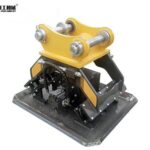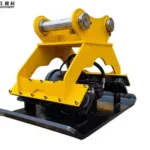Excavator vibrating plate compactor is a hydraulic attachment mounted on excavators, backhoes, or similar machinery. Its primary function is to compact soil, gravel, asphalt, or other granular materials to create a stable foundation. Unlike traditional compactors, which rely on static weight or manual operation, vibratory models use rapid vibrations to rearrange particles into a denser configuration. This process reduces air voids, increases load-bearing capacity, and minimizes settlement over time.
How Does a Vibratory Plate Compactor Work?
Hydraulic Power:
The excavator vibrating plate compactor draws hydraulic fluid from the excavator’s system, converting it into rotational motion via a hydraulic motor.
This motion drives an eccentric weight (or “exciter”) inside the compactor plate.
Vibration Generation:
As the eccentric weight spins, it creates centrifugal force, generating high-frequency vibrations.
These vibrations are transmitted to the compactor plate, which presses against the material being compacted.
Compaction Process:
The vibrations cause soil particles to shift, reducing friction and allowing them to settle into a tighter arrangement.
Simultaneously, the downward force from the excavator’s arm applies static pressure, enhancing compaction depth.
Features of Excavator Vibrating Plate Compactor
Adjustable Vibration Settings:
Customizable frequency and amplitude settings optimize performance across soil types.
Some models offer automatic adjustment based on real-time soil resistance data.
Robust Construction:
Heavy-duty steel plates and wear-resistant components ensure longevity in harsh environments.
Reinforced frames withstand repeated impacts and heavy loads.
Hydraulic Efficiency:
Low-flow hydraulic systems reduce energy consumption, making them compatible with a wide range of excavators.
Advanced models feature pressure relief valves to prevent hydraulic overload.
Applications Across Industries
- Infrastructure Development
From road construction to railway embankments, excavator vibrating plate compactor plays a pivotal role in preparing stable subgrades. Their ability to access confined spaces and navigate around obstacles makes them indispensable for trench backfilling, shoulder compaction, and bridge abutment reinforcement. - Utility Installations
In the installation of underground utilities, such as water pipes, sewer lines, and electrical conduits, vibratory plate compactors ensure the proper compaction of backfill material around the utilities, preventing settlement and potential damage. - Landscaping and Hardscaping
For creating level surfaces for patios, walkways, and retaining walls, vibratory plate compactors provide the necessary compaction to support the weight of pavers, stones, and concrete structures. - Disaster Recovery and Remediation
In the aftermath of natural disasters or environmental cleanups, vibratory plate compactors help stabilize soil, compact debris, and prepare sites for reconstruction.
Advantages of Using A Excavator Vibrating Plate Compactor
- High Efficiency and Speed
One of the greatest advantages of using this equipment is the speed and efficiency it brings to compaction tasks. Unlike manual compactors, it can cover a larger area in less time with superior results. - Improved Compaction Quality
Vibration and weight work together to provide deep, consistent compaction, reducing the risk of soil settlement or structural failure in the future. - Reduced Labor Costs
Attaching the compactor to an excavator eliminates the need for separate operators or standalone machines, thus saving on labor and equipment rental costs. - Safe Operation
Using an excavator-mounted compactor keeps operators safely inside the cab, away from potentially hazardous compaction zones.




